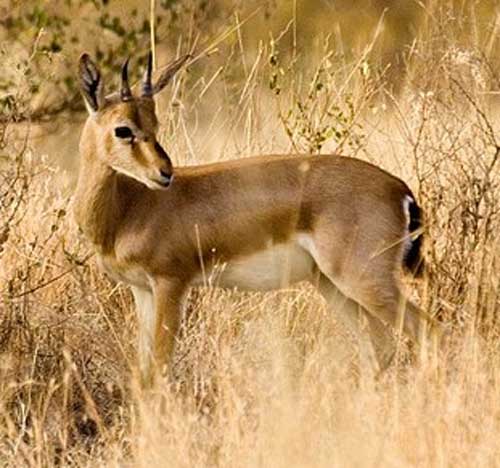Gazella bennettii, Photo: S. Shankar Cladus: Eukaryota Name Gazella bennettii (Sykes, 1831) References * Gazella bennettii on Mammal Species of the World. Vernacular names
The Chinkara (Gazella bennettii) is a species of gazelle found in south Asia. Habitat and Distribution It lives in grasslands and desert areas in India, Bangladesh and parts of Iran and Pakistan. It is also known as the Indian Gazelle (Gazella gazella bennetti). This gazelle stands at 65 centimetres and weighs about 23 kilograms. Its summer coat is a reddish-buff colour, with smooth, glossy fur. In winter the white belly and throat fur is in greater contrast. The sides of the face have dark chestnut stripes from the corner of the eye to the muzzle, bordered by white stripes. The horns reach over 39 centimetres.[1] Behaviour It is a shy animal and avoids human habitation. It can go without water for long periods and can get sufficient fluids from plants and dew. Although most individuals are seen alone, they can sometimes be spotted in groups of up to four animals.
It is preyed upon by leopards and dholes, and was a common prey item of the Asiatic Cheetah. It shares its habitat with several other herbivores, such as Nilgai, chital deer, wild goats, and wild boar. Certain researchers[who?] consider the decline in the Chinkara population as the reason behind the extinction of the Asiatic Cheetah in India. Its population is on the decline due to it being hunted for game. The Bishnoi community traditionally protect wildlife in the state of Rajasthan. In a famous case an Indian film star Salman Khan was sentenced to a 5 year prison sentence for shooting chinkara and blackbuck living under their protection. Another film star, Saif Ali Khan, faced similar allegations.
Source: Wikipedia, Wikispecies: All text is available under the terms of the GNU Free Documentation License |
|


